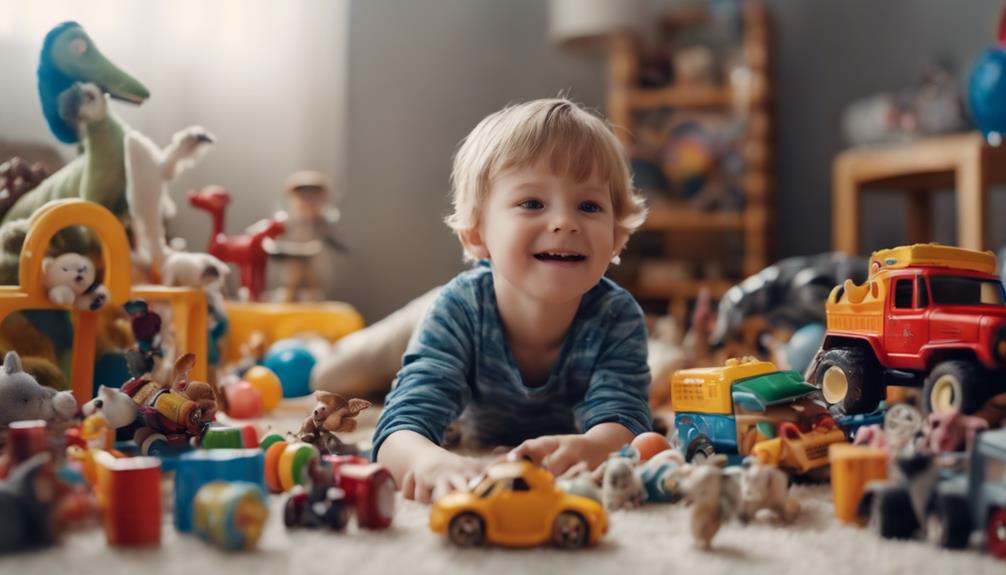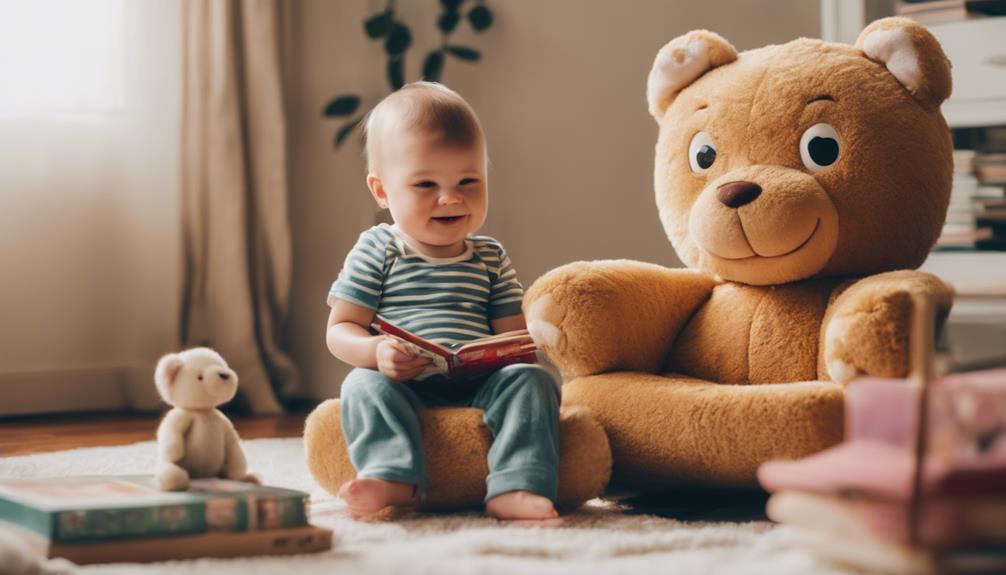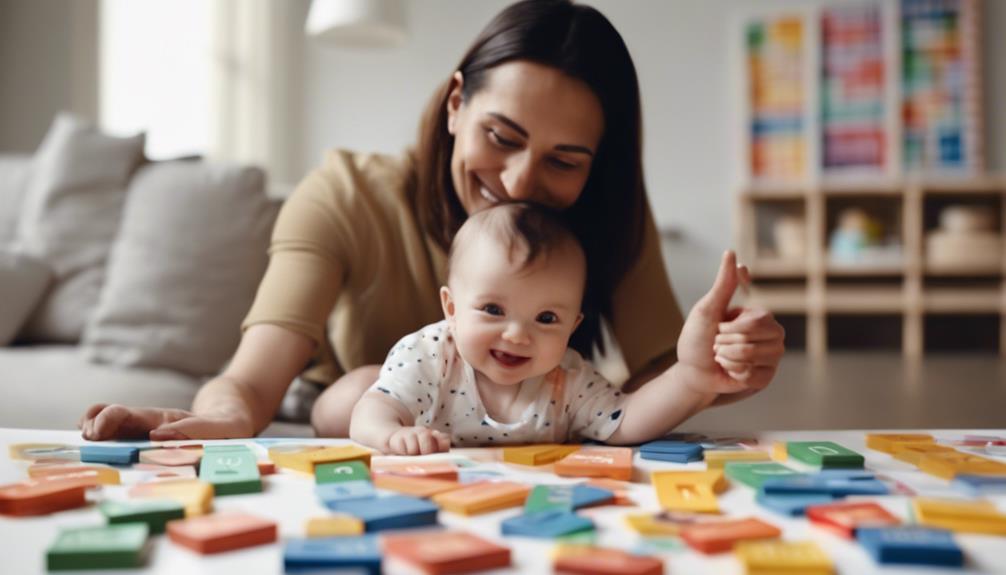Enhance your child’s language skills by using repetition, interactive choices, reading books, personalization, and daily conversations. By repeating words for memory retention, providing choices for improved communication skills, introducing new words through book reading, connecting vocabulary to their interests, and engaging in daily chats, you can effectively boost their vocabulary development.
Key Takeaways
- Repeat words in various contexts for vocabulary retention.
- Engage in interactive choice-based communication to enhance language skills.
- Read books to expose infants to new vocabulary and boost language development.
- Tailor learning to the child's interests for better retention.
- Have daily conversations using descriptive words and action verbs for vocabulary growth.
Repetition for Vocabulary Retention
Repeating words consistently is essential for helping infants and toddlers retain new vocabulary and strengthen their language skills. Babies benefit greatly from hearing words multiple times, as it helps solidify their understanding and memory of new vocabulary.
By repeating words in various contexts and situations, you can enhance vocabulary retention in babies, providing them with a strong foundation for language development. Consistent repetition of vocabulary not only aids in memory but also supports infants in incorporating new words into their growing language skills.
When you repeat words during everyday interactions with your little one, you're actively contributing to their language development and helping them expand their vocabulary. Remember, the key to boosting vocabulary retention in babies lies in the power of repetition and consistent exposure to new words in different settings and scenarios.
Interactive Choice-Based Communication

To further enhance your baby's language development, consider implementing interactive choice-based communication to encourage them to express their preferences and needs. Interactive choice-based communication involves providing options for your baby to make decisions, which not only promotes language development but also enhances their decision-making skills.
By engaging your baby in communication through choices, you're fostering their ability to express themselves and interact verbally. Offering alternatives for decisions supports language growth and encourages verbal communication in babies. This approach not only enhances engagement but also contributes to vocabulary expansion and overall language skill development.
Through interactive choice-based communication, you're creating a supportive environment for your baby to learn how to express their desires and needs effectively. By incorporating this strategy into your daily interactions, you're actively contributing to your baby's language development and communication skills.
Book Reading for Word Exposure
Engaging in regular book reading sessions with your baby exposes them to a diverse range of words and language structures, supporting their vocabulary development and language comprehension.
Reading books is a fantastic way to introduce your little one to new vocabulary and help them grasp context clues. By diving into stories and discussing pictures together, you enhance their word exposure and understanding.
This interactive activity isn't just about the words on the pages; it's about the shared experience and the language skills it fosters. Through regular book reading, you're laying the groundwork for your baby's language development, boosting their vocabulary, and setting the stage for strong early literacy skills.
Tailoring to Child's Interests

Tailoring language development to your child's interests enhances engagement and retention of new words by connecting vocabulary to activities they enjoy. By incorporating your child's interests into language activities, you create a personalized and effective learning experience.
When you relate new words to topics your child finds interesting, they're more likely to remember and use those words in daily conversations. Connecting vocabulary to your child's favorite activities or toys can make learning more enjoyable and effective.
Understanding and aligning with your child's preferences can lead to better language development outcomes. Remember, the key is to make learning fun and engaging by integrating your child's interests into language learning activities.
This approach not only enhances vocabulary retention but also fosters a positive attitude towards learning new words. So, be sure to tailor language development to your child's interests for a more engaging and effective vocabulary-building experience.
Daily Conversations for Vocabulary Growth
Have conversations with your baby daily to introduce them to a wide range of words and language patterns. By engaging in regular chats with your child, you can help boost their vocabulary and enhance their speech and language development.
Keep your language simple and clear, using descriptive words and action verbs to make it easier for your little one to understand and learn new words. Encourage interactive communication by responding to your baby's sounds and gestures, creating a back-and-forth dialogue that supports their language skills.
Make these daily conversations enjoyable and engaging by incorporating a mix of words, gestures, and facial expressions. This interactive approach not only aids in vocabulary growth but also strengthens your bond with your child.
Monitoring Milestones for Progress
To guarantee your baby's language development is progressing as expected, it's important to monitor milestones that indicate their vocabulary growth.
Tracking vocabulary milestones can provide valuable insights into your child's language development progress. Specific vocabulary benchmarks serve as indicators to help you assess if your child is on track with their language skills.
By regularly observing vocabulary growth, you can detect any potential language delays early on. This monitoring allows you to address any concerns promptly and seek professional help if needed.
Frequently Asked Questions
What Are 4 Ways You Can Help Your Baby's Language Skills Develop?
To help your baby's language skills develop, engage in conversations with simple words and full sentences, narrate routines and milestones, use different pitches, read books, label objects, and play together for an interactive and fun language learning experience.
How Can I Teach My Baby Vocabulary?
You can teach your baby vocabulary by talking, singing, and reading to them daily. Engage in activities that expose them to new words, celebrate their efforts, and create a positive learning environment. Enjoy watching their language skills bloom!
How Do Infants Build Their Vocabulary?
Infants build their vocabulary through exposure to words and interactions. Reading to them, talking, and using varied vocabulary around them are key. Your engagement and quality of language interactions greatly impact their vocabulary growth.
What Can Parents Do to Encourage an Infant's Language Development?
To encourage an infant's language development, engage in frequent conversations, use real words, and encourage nonverbal communication. Reading regularly, interactive play, and positive reinforcement help boost vocabulary. Celebrate their language attempts to foster confidence and learning.
Conclusion
In sum, boosting baby vocabulary development boils down to repetition, interaction, reading, tailoring, conversation, and monitoring.
These key strategies are essential for building your little one's language skills and setting them up for success.
So, take these tips and watch your baby's vocabulary blossom before your eyes!










